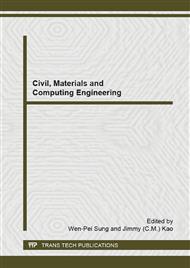p.423
p.427
p.432
p.436
p.440
p.451
p.456
p.460
p.464
Analysis of Managed Bus Lane Strategies Based on Microcosmic Traffic Simulation
Abstract:
In order todetermine the optimum Managed Bus Lane (MBL) strategies under different traffic conditions, it is essential tocompare the before-after traffic performanceswhen a MBL strategyis produced. Microscopictraffic simulation is often used to evaluate the effects of operation strategies on traffic performances. In addition to the commonly used bus lane strategies, the dedicated bus lane (DBL),intermittent bus lane (IBL) strategies were also studied byVISSIM in this study. Delay and time occupancy wereadopted as evaluation indexes in the evaluation. The analysis results showed that traffic condition has a great influence on the traffic performances for different managed bus lane strategies.Specifically, volumeplays a higher influence on the bus lane performance as compared tobus ratio. It is also shown that the DBL has the advantage of free buses from traffic interference but has the disadvantage of disrupting traffic. IBL strategies also can improve bus service and maintaingood car service. In addition, it is found that when both volume and bus ratio arelow, there is no need to implementany bus lane strategy;if the bus ratio is at a medium level, intermittent bus lanes-near intersection(IBL-NI) strategy is preferred; when the volume is high, intermittent bus lane-basic road segment(IBL-BRS) performsbetter. The results indicate that different MBL strategies should be consideredbased ontraffic conditions.This studycan provide some valuable information for traffic managers to address traffic congestion fromaperspective of transit priority.
Info:
Periodical:
Pages:
440-447
Citation:
Online since:
December 2014
Authors:
Price:
Сopyright:
© 2015 Trans Tech Publications Ltd. All Rights Reserved
Share:
Citation:


